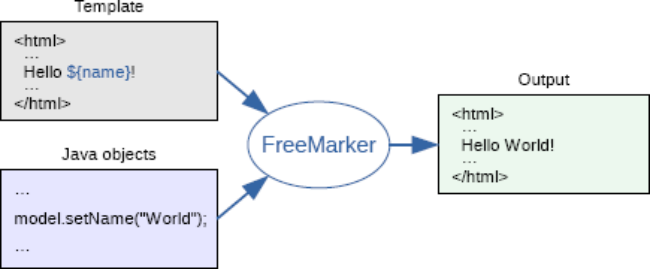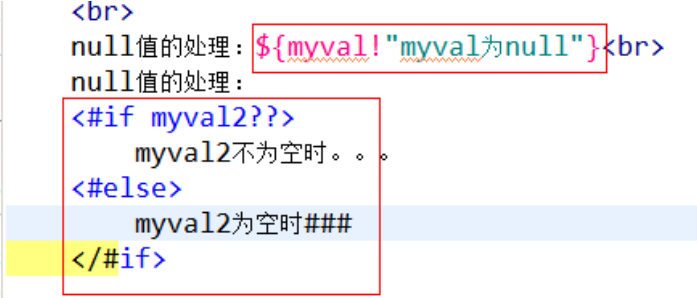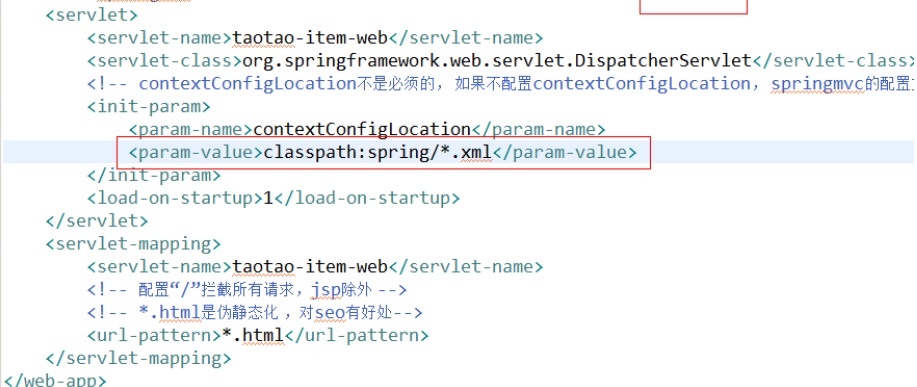Maven工程添加依赖
<dependency> <groupId>org.freemarker</groupId> <artifactId>freemarker</artifactId> <version>2.3.23</version> </dependency>
原理:

使用步骤:
第一步:创建一个Configuration对象,直接new一个对象。构造方法的参数就是freemarker对于的版本号。
第二步:设置模板文件所在的路径。
第三步:设置模板文件使用的字符集。一般就是utf-8.
第四步:加载一个模板,创建一个模板对象。
第五步:创建一个模板使用的数据集,可以是pojo也可以是map。一般是Map。
第六步:创建一个Writer对象,一般创建一FileWriter对象,指定生成的文件名。
第七步:调用模板对象的process方法输出文件。
第八步:关闭流。
模板:${hello}
@Test public void genFile() throws Exception { // 第一步:创建一个Configuration对象,直接new一个对象。构造方法的参数就是freemarker对于的版本号。 Configuration configuration = new Configuration(Configuration.getVersion()); // 第二步:设置模板文件所在的路径。 configuration.setDirectoryForTemplateLoading(new File("D:/workspaces-itcast/term197/taotao-item-web/src/main/webapp/WEB-INF/ftl")); // 第三步:设置模板文件使用的字符集。一般就是utf-8. configuration.setDefaultEncoding("utf-8"); // 第四步:加载一个模板,创建一个模板对象。 Template template = configuration.getTemplate("hello.ftl"); // 第五步:创建一个模板使用的数据集,可以是pojo也可以是map。一般是Map。 Map dataModel = new HashMap<>(); //向数据集中添加数据 dataModel.put("hello", "this is my first freemarker test."); // 第六步:创建一个Writer对象,一般创建一FileWriter对象,指定生成的文件名。 Writer out = new FileWriter(new File("D:/temp/term197/out/hello.html")); // 第七步:调用模板对象的process方法输出文件。 template.process(dataModel, out); // 第八步:关闭流。 out.close(); }
hello.ftl
${hello}
模板的语法
1.访问map中的key
${key}
${key.property}
2.访问pojo中的属性
<html> <head> <title>测试页面</title> </head> <body> 学生信息:<br> 学号:${student.id}<br> 姓名:${student.name}<br> 年龄:${student.age}<br> 家庭住址:${student.address}<br> 学生列表:<br> <table border="1"> <tr> <th>序号</th> <th>学号</th> <th>姓名</th> <th>年龄</th> <th>家庭住址</th> </tr> <#list stuList as stu> <#if stu_index%2==0> <tr bgcolor="red"> <#else> <tr bgcolor="blue"> </#if> <td>${stu_index}</td> <td>${stu.id}</td> <td>${stu.name}</td> <td>${stu.age}</td> <td>${stu.address}</td> </tr> </#list> </table> <br> 日期类型的处理:${date?string("yyyy/MM/dd HH:mm:ss")} <br> null值的处理:${val!} <br> 使用if判断null值: <#if val??> val是有值的。。。 <#else> val值为null。。。 </#if> <br> include标签测试: <#include "hello.ftl"> </body> </html>
取集合中的数据
<#list studentList as student> ${student.id}/${studnet.name} </#list> 循环使用格式: <#list 要循环的数据 as 循环后的数据> </#list>
取循环中的下标
<#list studentList as student> ${student_index} </#list>
判断
<#if student_index % 2 == 0> <#else> </#if>
日期类型格式化
直接取值:${date}(date是属性名)如果传来的是一个Date型数据会报错
${date?date} 2016-9-13
${date?time} 17:53:55
${date?datetime} 2016-9-13 17:53:55
Null值的处理
如果直接取一个不存在的值(值为null)时会报异常
${aaa}
处理: ${aaa!”默认值”}或者${aaa! }代表空字符串

Include标签
<#include “模板名称”> (相当于jstl中的包含)

Freemarker整合spring

<?xml version="1.0" encoding="UTF-8"?> <beans xmlns="http://www.springframework.org/schema/beans" xmlns:xsi="http://www.w3.org/2001/XMLSchema-instance" xmlns:p="http://www.springframework.org/schema/p" xmlns:context="http://www.springframework.org/schema/context" xmlns:dubbo="http://code.alibabatech.com/schema/dubbo" xmlns:mvc="http://www.springframework.org/schema/mvc" xsi:schemaLocation="http://www.springframework.org/schema/beans http://www.springframework.org/schema/beans/spring-beans.xsd http://www.springframework.org/schema/mvc http://www.springframework.org/schema/mvc/spring-mvc-4.2.xsd http://code.alibabatech.com/schema/dubbo http://code.alibabatech.com/schema/dubbo/dubbo.xsd http://www.springframework.org/schema/context http://www.springframework.org/schema/context/spring-context.xsd"> <bean id="freemarkerConfig" class="org.springframework.web.servlet.view.freemarker.FreeMarkerConfigurer"> <property name="templateLoaderPath" value="/WEB-INF/ftl/" /> <property name="defaultEncoding" value="UTF-8" /> </bean> </beans>
Controller
请求的url:/genhtml
参数:无
返回值:ok (String, 需要使用@ResponseBody)
业务逻辑:
1、从spring容器中获得FreeMarkerConfigurer对象。
2、从FreeMarkerConfigurer对象中获得Configuration对象。
3、使用Configuration对象获得Template对象。
4、创建数据集
5、创建输出文件的Writer对象。
6、调用模板对象的process方法,生成文件。
7、关闭流。
加载配置文件:

@Controller public class HtmlGenController { @Autowired private FreeMarkerConfigurer freeMarkerConfigurer; @RequestMapping("/genhtml") @ResponseBody public String genHtml()throws Exception { // 1、从spring容器中获得FreeMarkerConfigurer对象。 // 2、从FreeMarkerConfigurer对象中获得Configuration对象。 Configuration configuration = freeMarkerConfigurer.getConfiguration(); // 3、使用Configuration对象获得Template对象。 Template template = configuration.getTemplate("hello.ftl"); // 4、创建数据集 Map dataModel = new HashMap<>(); dataModel.put("hello", "1000"); // 5、创建输出文件的Writer对象。 Writer out = new FileWriter(new File("D:/temp/term197/out/spring-freemarker.html")); // 6、调用模板对象的process方法,生成文件。 template.process(dataModel, out); // 7、关闭流。 out.close(); return "OK"; } }